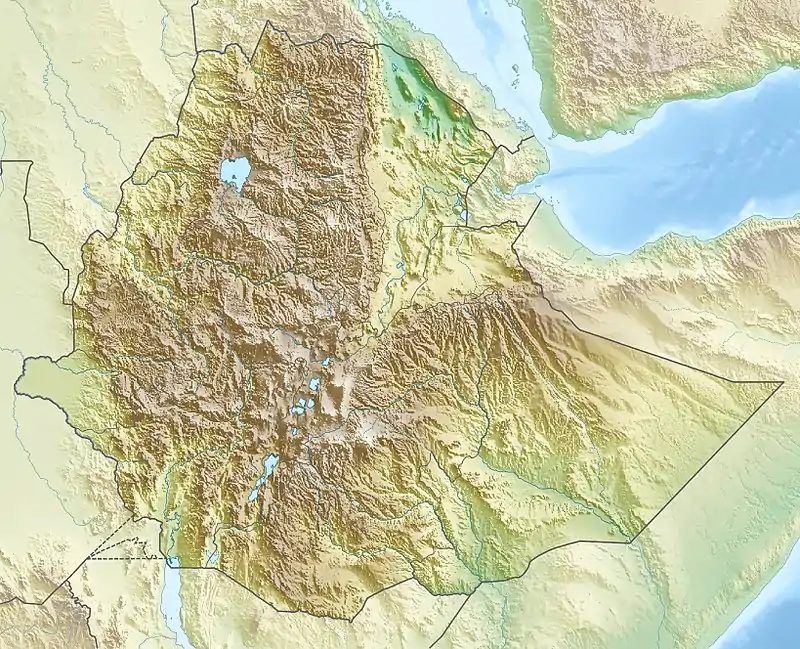Melka Kunture
Melka Kunture (መልካ ቁንጥሬ) is a Paleolithic site in the upper Awash Valley, Ethiopia. It is located 50 kilometers south of Addis Ababa by road, across the Awash River from the village of Melka Awash. Three waterfalls lie downstream of the bridge across the Awash here, which provides access south to Butajira.[1]
| Melka Kunture | |
|---|---|
 location of Melka Kunture | |
| Coordinates | 8.7051°N 38.5991°E |
History of research
The site, discovered by Gerard Dekker in 1963, was surveyed by Gérard Bailloud in 1964, and then systematically explored by a French mission directed by Jean Chavaillon (1965-1982 / 1993-1995). Since 1999, an Italian mission directed by Marcello Piperno for the Italian Ministry of Foreign Affairs and the University of Rome “La Sapienza” has worked at the site in agreement with the Authority for Research and Conservation of Cultural Heritage of the Ethiopian Ministry of Culture and Tourism and the Oromia Culture and Tourism Bureau.
Archaeological sequences
Archaeologists have uncovered over 30 occupation sites at Melka Kunture. The finds are dated by volcanic depositions left by eruptions of Mount Zuqualla, northeast of Melka Kunture.[2]
The sequence begins with the Oldowan site of Karre, about 1.7 million years old, which can be correlated to level B of Gombore I, on the right bank of the Awash. A probably contemporaneous Oldowan site is documented at Garba IV. The magneto-stratigraphic sequence of Jaramillo lies between Tuff A, which overlies the Oldowan sites, and Tuff B, which is dated between 1.0 and 0.84 million years ago. Some important sites, such as Garba XII and Simbiro III, datable to a transitional phase from the late Oldowan to the Early Acheulean (Garba XII) or to an archaic phase of the Acheulean (Simbiro), also lie within this chronological span.
A later phase of the African Acheulean is well represented by several sites in the area of Gombore II (dated to about 0.8 mya). The latest Acheulean site is Garba I, dated to ca. 0.5 mya, while the end of this long sequence is represented, at Melka Kunture, by the site of Garba III, approximately dated to 0.2 mya, which can be regarded as a transitional site towards the Middle Stone Age. Some of the above-listed levels yielded hominid remains: a humerus fragment of H. cf. erectus at Gombore I; a hemimandible of a H. cf. erectus child at Garba IV; two H. erectus skull fragments at Gombore II; and three archaic H. sapiens skull fragments at Garba III.
The East African Later Stone Age is poorly documented at Melka Kunture, being represented so far by some finds at Wofi and Kella. A little less than 7 km from Melka Kunture, in a site known as Balchit, are imposing outcrops of obsidian. As recent analyses from samples from several sites in Melka Kunture bear out, these outcrops were used, ever since the earliest Oldowan phases, as an important source of raw material. The exploitation of obsidian in the Melka region went on until historical times, leaving numerous and extensive accumulations of tens of thousands of blades, cores, and scars of this volcanic rock.
Exhibits
A museum was built at the site by the Oromia Culture and Tourism Commission with financial assistance from the European Community, consisting of four buildings with exhibits—one on prehistoric Africa, another on geology and volcanology, a third on paleoanthropology, the fourth on the prehistory of Melka Kunture. There is also an "Open Air Museum," which displays the excavation of two Acheulean sites that have been dated to 0.8 million years BP.[3] Currently (May, 2016) a new museum is under construction, which is funded by the World Bank. [4]
Notes
- Philip Briggs, Ethiopia: The Bradt Travel Guide, 3rd edition (Chalfont St Peters: Bradt, 2002), p. 374
- Paul B. Henze, Layers of Time (New York: Palgrave, 2000), p. 8
- "Melka Kunture - Home", University of Rome, "La Sapienza", Dipartimento di Scienze dell’Antichità.
- As told by guide during site visit.
External links
- "Melka Kunture", University of Rome, "La Sapienza", Dipartimento di Scienze dell’Antichità.
- Jean Chavaillon and Marcello Piperno (editors), Studies on the Early Paleolithic site of Melka Kunture, Ethiopia. Florence: Istituto Italiano di Preistoria e Protostoria, 2004.